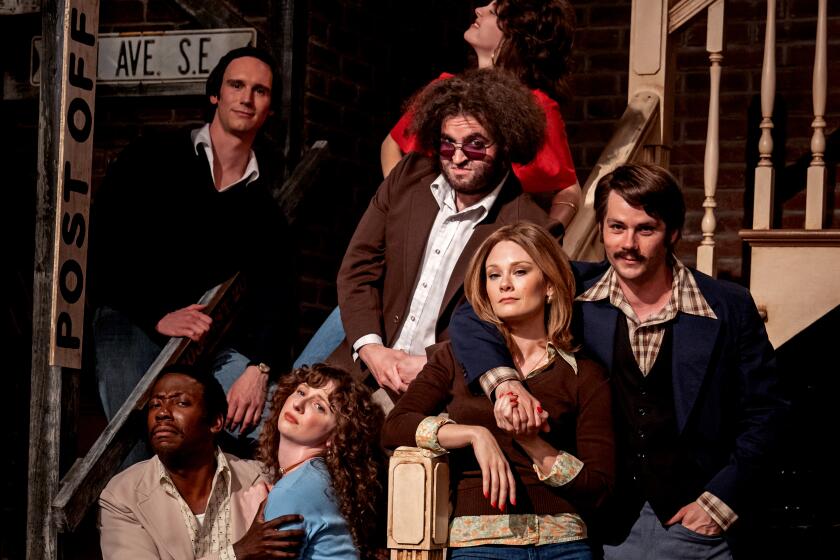Season’s Greetings: Oscar Ads
“For Your Consideration . . . “ Three words that signal the beginning of awards season--and a larger-than-usual holiday windfall for the entertainment industry trade publications.
Each year at this time, the major studios and independents take out advertisements heralding their best in the hope of influencing the Oscar race. Sometimes, these ads appear well before the movies they tout have come out. On at least one film--New Line Cinema’s “In Love and War”--last-minute changes were still being made.
The barrage may escape the average moviegoer but leap out at readers of the trades. In a recent issue of Daily Variety, 17 1/2 of the 40 pages were soaked up by these not-so-subliminal messages. The Hollywood Reporter’s Women in Entertainment issue contained 25 pages’ worth. Advertising comprises about 80% of the annual revenues of these two operations, sources say, of which the “for your consideration ads” make up a healthy share.
“Our bookings are up from last year because there are no ‘Forrest Gumps’--no $100-million rave review movies,” said Robert J. Dowling, publisher and editor in chief of the Hollywood Reporter. “That throws the arena open to everyone and levels the playing field.”
The value extends beyond the Oscars, however, according to Variety publisher Gerry Byrne. “These ads are a means of penetrating the foreign market, for public companies to show Wall Street what they’ve been up to, and for studios to demonstrate to the creative community they’ll support them if they perform well,” he said.
Even if they don’t perform well, insiders say, the incentive is there to take out these ads. Why have “Sleepers” and “The Frighteners”--movies that met with decidedly mixed critical response--been offered up as best picture nominees? Because in a town built on relationships, it’s a way of cultivating and cementing them.
“It’s all about relationships,” said Russell Schwartz, president of Gramercy Pictures, which has bought ads for “Fargo” and the upcoming “Portrait of a Lady.” “But, despite calls from miffed agents and managers, we don’t have the budget to massage everyone’s ego. Gramercy only supports films we think are legitimate contenders--and because there’s a numbing effect after the first few weeks, we tried to be out first this year.”
A marketing chief at a major studio acknowledged that “a lot of craziness” comes into play. “Movies can totally flop commercially and be unrecognized in terms of critical acclaim,” he said. “But studios are blind to that--or adopt an ‘If you want it, we’ll do it’ approach to maintain these bonds.”
Guarantees for ad campaigns are on occasion part of an actor’s contract. In other cases, talent has been known to bring pressure on the studios. One high-level executive recalled that a star’s manager was so desperate that he offered to split the cost with the studio. Hoping to curry favor with the actor for a picture down the road, it agreed.
“It’s not any secret that deals go on--though the percentage is probably small,” says Variety’s Byrne.
Since academy members are bombarded with cassettes, these ads help a movie stand out. They also jog the memory about well-received pictures that opened early in the year. Still, their impact on the Oscar balloting is open to debate.
“Ads are good for creating awareness but when it comes to changing the minds of voters they probably have little effect,” said Robert Levin, president of worldwide marketing for Columbia/TriStar Pictures, who is taking out ads for “Jerry Maguire,” “The Mirror Has Two Faces” and “The People vs. Larry Flynt” nonetheless.
*
Ads for lower-budget independent films are a major part of the mix.
“There’s a bigger upside for independents to land a nomination,” said Mitch Goldman, president of marketing and distribution for New Line Cinema, which is campaigning for “Shine,” “Grass Harp,” “Set It Off,” “In Love and War” and “Michael.” “We’re the little guys and rely more on critical acclaim to get a picture out. What we spend on nominations comes back tenfold if it works. Nominations are printed in the newspapers and are all over TV. It’s a tremendous megaphone put in place for someone with a squeaky voice.”
There’s a barrage of ads between Thanksgiving and today, when the Golden Globe nominations come out. After a holiday lull, they pick up again in January, ending the 31st when the Oscar nomination ballots are due. A smaller, less costly wave surfaces in February after the nominees are announced.
These campaigns don’t come cheap. A full-page color ad in Daily Variety costs $7,525 and $6,900 in the Hollywood Reporter--with premium positions costing more.
Until the Oscar nominations, Gramercy’s Schwartz’s spending plans will vary widely on each of his 17 releases, from $50,000 to $500,000 for mailings, screenings and cassettes as well as these ads. Insiders say that Sony is spending $50,000 on a low-level ad campaign for “The People vs. Larry Flynt,” but as much as $300,000 if it makes the cut. Depending on how hungry a company is, that figure could run as high as $1 million in some cases.
Though an Academy Award has long-term financial value when it comes to cutting television, video and international deals, lobbying for one, Goldman said, can be counterproductive.
“I sense a backlash,” Goldman said. “The more you spend to woo academy voters, the less likely they are to vote for you.”










